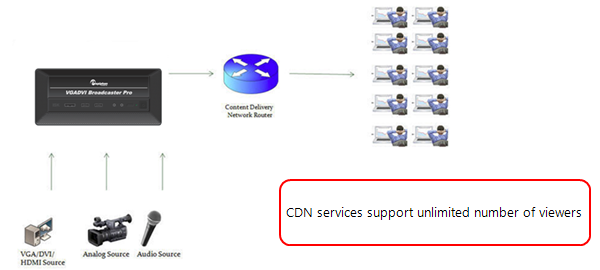Streaming to a CDN, multicasting, and streaming to multiple destinations
A Content Delivery Network (CDN) relies on geo-diverse CDN servers to receive and disperse web content to the CDN server closest to the user. The closer the server is to the user, the faster the content is delivered. Streaming your content through a CDN allows you to stream any time, anywhere, regardless of the viewing device and you don't have to worry about maintaining your own video streaming servers on site.

Streaming content to a multicast IP address is different than streaming to a CDN. Multicasting lets you directly share the stream with multiple viewers on the same LAN. All viewers receive the same stream at the same time. Similar to turning on a radio station where all listeners hear the same music at the same time. Multicasting is useful for training sessions when there is a specific time frame for the audience to view the content live.
Pearl-2 can publish to multiple destinations at the same time.
| Publishing Options | Use this option to... |
|---|---|
| Content Distribution Network (CDN) |
Stream web content to many viewers on different Content Delivery Networks simultaneously to any geographical location. Using a CDN to host your broadcast is highly scalable and saves you from having to purchase and maintain your own servers to host and deliver video content. Using one or more CDNs to stream live content allows you to reach a large geographically diverse audience and because CDNs perform format conversion, the stream is platform independent. Streaming protocols supported include: SRT (push), HLS (push), RTMP/RTMPS, For more information about streaming to a CDN, see Streaming to servers, CDNs, and other devices. |
| Multicast Streaming |
This delivery method relies on network equipment that supports multicasting and is usually used on high bandwidth corporate LANs and not on Internet-based architectures. Multicasting is what's typically used to stream video and audio to an IP TV or set-top box playlist. If you're streaming over a Gigabit Ethernet network to a 10/100 Mbps set-top box that is dropping frames, you can limit the stream's bandwidth, see Set up traffic shaping. Multicast streaming protocols supported include: MPEG-TS UDP, MPEG-TS RTP/UDP, and RTP/UDP. For more information about using multicasting for streaming your content, see Multicast streaming. |
To stream video outside of your LAN, use a CDN or configure port forwarding on your router. Consult your Network Administrator to set up port forwarding.
By default, no streaming is configured for the channels configured on Pearl-2.
Publishing to a CDN
When you publish a stream to a CDN provider, make sure you use a streaming protocol that the CDN supports. Contact your CDN for a list of supported streaming protocols and audio codecs they support.
To publish content to a CDN provider, ensure you have:
- the URL (or path) to the mount point or an XML configuration file (provided by the CDN provider)
- the supported transport protocols, audio codecs, and any other settings like key frame rates and bit rates recommended by the CDN provider
- See Suggested stream settings for the best streaming settings for Pearl-2.
You can control streaming to a CDN using the Admin panel.
- Pearl-2 and Pearl Mini - touch screen
For more information see Start and stop streaming to a CDN.
You can also test how your content is streamed by sending your content to Epiphan’s CDN. For a list of Epiphan’s preferred CDN providers, see: https://www.epiphan.com/partners/cdn-partners/.
Streaming to multiple destinations
There are a few different ways to stream to multiple destinations using Pearl-2. One option is to configure a channel on Pearl-2 as your switched program channel, then use the Admin panel to create multiple streaming destinations for that channel. You can add multiple RTMP streams to different CDNs, configure multicast streaming, and even share the live broadcast link with viewers on your network all at the same time. But remember, the more streams you configure, the more network bandwidth you need. To stream to CDNs and multicast a channel at the same time, the channel must have H.264 configured as the channel encoding
Another option is to set up multiple channels on Pearl-2 and stream those using the Admin panel. That way, you can configure each channel with different encoding settings. For example, you can configure one channel with the streaming specifications for YouTube and configure the second channel for streaming to Facebook. Using one channel as your main switched program, use Pearl-2's channel as a source feature to feed that channel into your second channel. That way, you're streaming the exact same switched program to different destinations at different encoding settings. For information about using a channel as a source, see Add video sources or a channel as a source.
As you can see, setting up streaming to multiple destinations is very flexible with Pearl-2.

